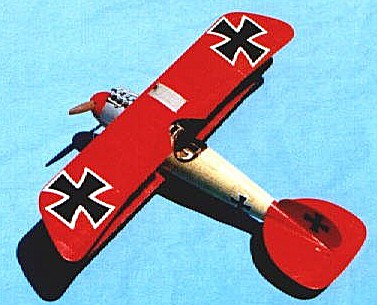
Kit: ALBATROS D.V - "RED BARON"
Scale: 1/48
Maufacturer: Eduard
Price: MSRP - $24.95
Media: limited-run injection-molded plastic with photo-etch brass detail.
Decals: two different Albatros D.V's flown by Manfred von Richtofen.
Accuracy: right on.
Overall: A+
Reviewed by: Thomas McKelvey Cleaver (THE AERONUT)

The Albatros series of fighters were among the most important and well-known aircraft used by the German Air Force during the First World War. The D.I and D.II were both biplanes, and were responsible for wresting air superiority from the Royal Flying Corps in late-1916/early-1917. The D.III came in early 1917, and was responsible for the defeat of the Albatros by design deficiency: impressed by the Nieuport series of sesquiplanes, Albatros went to a single-spar lower wing with V-strut outer connection to the upper wing, like the Nieuport. This weak design led to the Albatros losing its lower wing in a diving-and-turning dogfight, and pilots could no longer throw the fighter around with abandon, as they had with the D.I and D.II. The D.V was the last of the line, appearing in mid-1917. By 1918, the day of the Albatros was clearly over, being replaced that Spring by the incredible Fokker D.VII, the best fighter of the war.
Eduard is the leading manufactuer of 1/48 World War I aircraft, and the Albatros D.V is one of their best offerings to date. Beginning with the Sopwith Pup, released just before this kit, the company has introduced a limited-run injection-molding process that results in thin wings and clean molds easily comparable to anything put out by TamiGawa.
The Albatros D.V is the first kit released in limited editions with markings for particular aces who flew it. In this case, they are two aircraft flown by Rittmeister Manfred von Richtofen in 1917: one the aircraft in which he was shot down and wounded in August 1917, and the other the D.V he flew when not flying his more famous Fokker Dr.I triplane in late 1917/early 1918. I chose the first aircraft, because it is an Albatros with the fuselage left in natural-wood finish, with only the upper wings, nose and tail painted red. I used SuperScale's wonderful "wood finish" decal sheet to do this, in this case using the "light wood." I cut the sheet to fit various panels per the engraved panel lines on the fuselage, so that the "wood grain" was not uniform, since this is the way the Albatros was actually constructed. With the decal sheet, it is easy to do and looks great afterwards.
As far as overall accuracy is concerned the kit's right on according to the drawings in the Windsock Datafile. The wings are thin, the various pieces fit well and assembly is straightforward, with only a very litle flash to clean up. This is perhaps the easiest Eduard kit I've done to date. The rigging is simple, as it was on most German single-seaters, and I resorted to my old reliable .008" brass wire painted silver and cut to length.
If you've been contemplating doing a World War I airplane, I recommend this and Eduard's Pfalz D.III as the kits to try first. Try them - you'll like 'em!